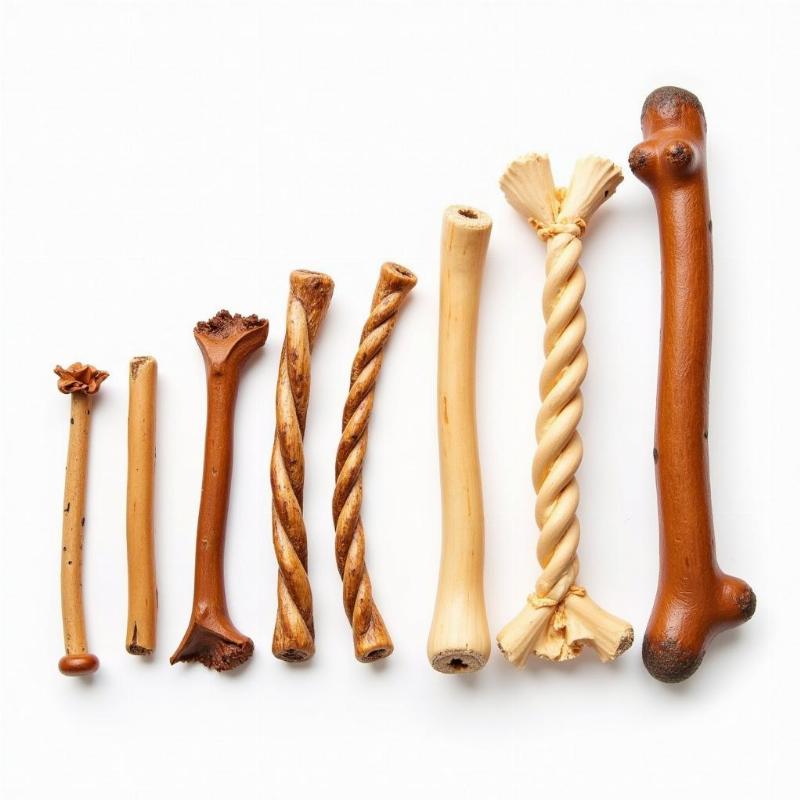Bully sticks have become a popular chew treat for dogs in the US, but are bully sticks good for dogs? The answer, like most things related to pet care, isn’t a simple yes or no. While bully sticks offer certain benefits, it’s crucial for owners to understand the potential risks and make informed decisions for their furry friends. This guide will cover everything you need to know about bully sticks, from their nutritional value to safety concerns, helping you determine if they’re a good fit for your canine companion.
Bully sticks, also known as pizzle sticks, are dried bull penises. While the origin might sound unappealing to us, dogs seem to find them incredibly enticing. Their chewy texture provides a satisfying gnawing experience, which can be especially beneficial for teething puppies or dogs prone to anxiety. But are these chews actually healthy? Let’s dive deeper into the pros and cons.
The Benefits of Bully Sticks for Dogs
Bully sticks offer several potential advantages for dogs, making them a popular choice among pet owners:
- Dental Health: The chewing action can help scrape away plaque and tartar buildup, promoting good dental hygiene and potentially freshening breath. This can be a significant benefit, especially for breeds prone to dental issues.
- Mental Stimulation: Gnawing on a bully stick can keep a dog entertained and mentally stimulated, which can be helpful in preventing boredom and destructive behaviors. This is particularly beneficial for dogs left alone for extended periods.
- Natural and Easily Digestible: Compared to some rawhide alternatives, bully sticks are generally considered more digestible, minimizing the risk of gastrointestinal blockages.
- High in Protein: Bully sticks are a good source of protein, which is essential for muscle development and overall health.
- Low in Fat: They are relatively low in fat compared to many other dog treats, making them a healthier option for weight management.
Potential Risks of Bully Sticks for Dogs
Despite the benefits, bully sticks also pose certain risks that owners should be aware of:
- Choking Hazard: Small pieces can break off, posing a choking hazard, especially for small dogs or aggressive chewers. Supervision is always crucial when giving a dog a bully stick.
- Stomach Upset: While generally digestible, some dogs might experience stomach upset, vomiting, or diarrhea after consuming bully sticks. Introducing them gradually can help minimize these risks.
- Salmonella Risk: Like any animal product, there’s a potential risk of salmonella contamination. Choosing reputable brands and proper storage can help mitigate this risk.
- Odor: Bully sticks have a distinct odor that some owners find unpleasant. While not harmful, the smell can be quite strong, especially for more sensitive noses.
- Variability in Quality: The quality of bully sticks can vary significantly between brands. Some may be thinner, harder, or contain added chemicals, which can pose additional risks.
Choosing the Right Bully Stick for Your Dog
 Different types of bully sticks
Different types of bully sticks
If you decide to give your dog bully sticks, choosing the right size and thickness is crucial for safety:
- Small Dogs: Opt for thin, six-inch bully sticks to minimize the choking hazard.
- Medium Dogs: Standard six-inch or thicker bully sticks are generally appropriate.
- Large Dogs: Choose thicker, longer bully sticks or braided options to provide a longer-lasting chew.
Always supervise your dog while they are chewing on a bully stick and remove it when it becomes small enough to be swallowed whole.
Alternatives to Bully Sticks
If you’re concerned about the potential risks of bully sticks, several safer alternatives exist, including:
These options can provide similar benefits without some of the risks associated with bully sticks.
Are Bully Sticks Right for My Dog?
Ultimately, the decision of whether or not to give your dog bully sticks is a personal one. Weighing the potential benefits and risks, along with your dog’s individual chewing habits and health conditions, can help you make the best choice for your furry friend. Consulting with your veterinarian can also provide valuable insights tailored to your dog’s specific needs.
Conclusion
Bully sticks can be a enjoyable and healthy treat for dogs when chosen and used responsibly. By understanding the potential benefits and risks, and following the guidelines outlined in this article, you can make an informed decision about whether bully sticks are a suitable addition to your dog’s diet.
FAQ
- How often can I give my dog a bully stick? Offering a bully stick a few times a week is generally sufficient. Overconsumption can lead to digestive issues or weight gain.
- What if my dog swallows a large piece of bully stick? Contact your veterinarian immediately if you suspect your dog has swallowed a piece that could cause blockage.
- Are all bully sticks the same? No, quality varies significantly between brands. Look for natural, odor-free bully sticks from reputable sources.
- Can puppies have bully sticks? Yes, but always supervise them and choose thin, small bully sticks to prevent choking.
- What should I do with the leftover small piece of a bully stick? Discard the small piece once it becomes a choking hazard. Never allow your dog to chew it down to a size that could be swallowed whole.
- Are there any breeds that should avoid bully sticks? Dogs with sensitive stomachs or aggressive chewing habits might be better suited with alternative chews.
- Where can I buy high-quality bully sticks? Reputable pet stores and online retailers specializing in natural dog treats are good places to start.
Related Articles on Beautdogs.us
Beautdogs.us is your premier source for all things dog-related in the US. We offer expert advice on dog breeds, care, and product recommendations. Whether you’re a new dog owner or a seasoned pro, Beautdogs.us is your trusted companion on your dog ownership journey. Contact us at [email protected] or call us at +1 501-555-7529 for any questions or inquiries.